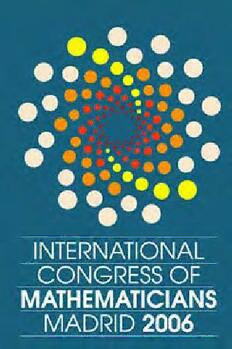
Proceedings of International congress of mathematicians PDF
Preview Proceedings of International congress of mathematicians
Contents 1 Logicandfoundations RodDowney Algorithmicrandomnessandcomputability ................................ 1 ItayNeeman Determinacyandlargecardinals .......................................... 27 MichaelRathjen Theartofordinalanalysis ............................................... 45 ThomasScanlon Analyticdifferencerings ................................................. 71 SimonThomas Borelsuperrigidityandtheclassificationproblemforthetorsion-free abeliangroupsoffiniterank .............................................. 93 2 Algebra WilliamCrawley-Boevey Quiveralgebras,weightedprojectivelines,andtheDeligne–Simpson problem ................................................................ 117 MarcusduSautoy*andFritzGrunewald* Zetafunctionsofgroupsandrings ........................................ 131 BernhardKeller Ondifferentialgradedcategories ......................................... 151 RaphaëlRouquier Derivedequivalencesandfinitedimensionalalgebras ....................... 191 MarkSapir Algorithmicandasymptoticpropertiesofgroups ........................... 223 ÁkosSeress Aunifiedapproachtocomputationswithpermutation andmatrixgroups ....................................................... 245 AgataSmoktunowicz Someresultsinnoncommutativeringtheory ............................... 259 3 Numbertheory ManjulBhargava Highercompositionlawsandapplications ................................. 271 ∗ Incaseofseveralauthors,invitedspeakersaremarkedwithanasterisk. vi Contents Ching-LiChai HeckeorbitsasShimuravarietiesinpositivecharacteristic .................. 295 HenriDarmon Heegnerpoints,Stark–Heegnerpoints,andvaluesofL-series ............... 313 KazuhiroFujiwara GaloisdeformationsandarithmeticgeometryofShimuravarieties ........... 347 BenGreen GeneralisingtheHardy–Littlewoodmethodforprimes ...................... 373 GérardLaumon AspectsgéométriquesduLemmeFondamental deLanglands-Shelstad ................................................... 401 PhilippeMichel*andAkshayVenkatesh Equidistribution,L-functionsandergodictheory: onsomeproblemsofYu.Linnik .......................................... 421 WiesławaNizioł p-adicmotiviccohomologyinarithmetic .................................. 459 ChristopherSkinner*andEricUrban* VanishingofL-functionsandranksofSelmergroups ....................... 473 VinayakVatsal SpecialvaluesofL-functionsmodulop ................................... 501 4 Algebraicandcomplexgeometry ValeryAlexeev Higher-dimensionalanaloguesofstablecurves ............................. 515 Jean-BenoîtBost Evaluationmaps,slopes,andalgebraicitycriteria .......................... 537 TomBridgeland Derivedcategoriesofcoherentsheaves .................................... 563 LawrenceEin*andMirceaMusta¸taˇ Invariantsofsingularitiesofpairs ......................................... 583 TomGraber Rationalcurvesandrationalpoints ........................................ 603 Jun-MukHwang Rigidityofrationalhomogeneousspaces .................................. 613 TomohideTerasoma Geometryofmultiplezetavalues ......................................... 627 YuriTschinkel Geometryovernonclosedfields .......................................... 637 JarosławWłodarczyk AlgebraicMorsetheoryandtheweakfactorizationtheorem ................. 653 Contents vii 5 Geometry ChristophBöhmandBurkhardWilking* Manifoldswithpositivecurvatureoperatorsarespaceforms ................. 683 SimonBrendle Ellipticandparabolicproblemsinconformalgeometry ..................... 691 KoHonda Thetopologyandgeometryofcontactstructuresin dimensionthree ......................................................... 705 MichaelKapovich Generalizedtriangleinequalitiesandtheirapplications ..................... 719 BruceKleiner Theasymptoticgeometryofnegativelycurvedspaces: uniformization,geometrizationandrigidity ................................ 743 FrançoisLalonde Lagrangiansubmanifolds: fromthelocalmodeltotheclustercomplex ....... 769 XiaoboLiu Gromov–Witteninvariantsandmodulispacesofcurves ..................... 791 ToshikiMabuchi Extremalmetricsandstabilitiesonpolarizedmanifolds ..................... 813 GrigoryMikhalkin Tropicalgeometryanditsapplications .................................... 827 WilliamP.MinicozziII Embeddedminimalsurfaces ............................................. 853 Yong-GeunOh*andKenjiFukaya Floerhomologyinsymplecticgeometryandinmirrorsymmetry ............ 879 AntonioRos Properlyembeddedminimalsurfaceswithfinitetopology ................... 907 Chuu-LianTerng Applicationsofloopgroupfactorizationtogeometricsolitonequations ....... 927 6 Topology IanAgol FinitenessofarithmeticKleinianreflectiongroups ......................... 951 MartinR.Bridson Non-positivecurvatureandcomplexityforfinitelypresentedgroups ......... 961 MikhailKhovanov Linkhomologyandcategorification ....................................... 989 YairN.Minsky Curvecomplexes,surfacesand3-manifolds ............................... 1001 viii Contents FabienMorel A1-algebraictopology ................................................... 1035 KaoruOno DevelopmentinsymplecticFloertheory ................................... 1061 PeterOzsváth*andZoltánSzabó* HeegaarddiagramsandFloerhomology ................................... 1083 KarenVogtmann Thecohomologyofautomorphismgroupsoffreegroups .................... 1101 7 LiegroupsandLiealgebras RomanBezrukavnikov NoncommutativecounterpartsoftheSpringerresolution .................... 1119 AlexanderBraverman Spacesofquasi-mapsintotheflagvarietiesandtheirapplications ............ 1145 GuyHenniart OnthelocalLanglandsandJacquet–Langlandscorrespondences ............ 1171 NicolasMonod Aninvitationtoboundedcohomology ..................................... 1183 Bao-ChâuNgô FibrationdeHitchinetstructureendoscopiquedelaformule destraces .............................................................. 1213 EricM.Opdam Heckealgebrasandharmonicanalysis .................................... 1227 PeterSchneider Continuousrepresentationtheoryofp-adicLiegroups ..................... 1261 YehudaShalom ThealgebraizationofKazhdan’sproperty(T) .............................. 1283 DavidSoudry Rankin–Selbergintegrals,thedescentmethod,andLanglands functoriality ............................................................ 1311 BirgitSpeh Representationtheoryandthecohomologyofarithmeticgroups ............. 1327 TonnyA.Springer Someresultsoncompactificationsofsemisimplegroups .................... 1337 8 Analysis MarioBonk Quasiconformalgeometryoffractals ...................................... 1349 Contents ix SteveHofmann LocalTbtheoremsandapplicationsinPDE ............................... 1375 SergeyV.Konyagin AlmosteverywhereconvergenceanddivergenceofFourierseries ............ 1393 LindaPreissRothschild IteratedSegremappingsofrealsubmanifolds incomplexspaceandapplications ........................................ 1405 StanislavSmirnov Towardsconformalinvarianceof2Dlatticemodels ......................... 1421 EmilJ.Straube AspectsoftheL2-Sobolevtheoryofthe∂-Neumannproblem ............... 1453 VladimirN.Temlyakov Greedyapproximationswithregardtobases ............................... 1479 XavierTolsa Analyticcapacity,rectifiability,andtheCauchyintegral ..................... 1505 9 Operatoralgebrasandfunctionalanalysis FranckBarthe TheBrunn–Minkowskitheoremandrelatedgeometricand functionalinequalities ................................................... 1529 Bo’azKlartag Isomorphicandalmost-isometricproblemsinhigh-dimensional convexgeometry ........................................................ 1547 NarutakaOzawa Amenableactionsandapplications ........................................ 1563 MikaelRørdam StructureandclassificationofC∗-algebras ................................ 1581 StanislawJ.Szarek Convexity,complexity,andhighdimensions ............................... 1599 GuoliangYu Higherindextheoryofellipticoperatorsandgeometryofgroups ............ 1623 10 Ordinarydifferentialequationsanddynamicalsystems OlegN.Ageev Onspectralinvariantsinmodernergodictheory ............................ 1641 VitalyBergelson ErgodicRamseytheory: adynamicalapproachtostatictheorems ............ 1655 NikolaiChernovandDmitryDolgopyat* Hyperbolicbilliardsandstatisticalphysics ................................. 1679 x Contents RafaeldelaLlave Somerecentprogressingeometricmethodsintheinstabilityproblem inHamiltonianmechanics ............................................... 1705 ManfredEinsiedlerandElonLindenstrauss* Diagonalizableflowsonlocallyhomogeneousspacesandnumbertheory ..... 1731 Authorindex ............................................................... 1761 Algorithmic randomness and computability RodDowney Abstract. We examine some recent work which has made significant progress in out under- standingofalgorithmicrandomness,relativealgorithmicrandomnessandtheirrelationshipwith algorithmiccomputabilityandrelativealgorithmiccomputability. MathematicsSubjectClassification(2000). Primary68Q30,68Q15,03D15,03D25,03D28, 03D30. Keywords. Kolmogorovcomplexity,computability,degreesofunsolvability,prefix-freecom- plexity,lowness,incompressibility,martingales,computablyenumerable. 1. Introduction Inthelastfewyearswehaveseensomeveryexcitingprogressinourunderstanding of algorithmic randomness and its relationship with computability and complexity. Theseresultshavecenteredaroundaprogrammewhichattemptstoanswerquestions of the following form: when is one real more random than another? How should thisbemeasured? Howwouldsuchmeasuresofcalibrationrelatetoothermeasures of complexity of reals, such as the traditional measures of relative complexity like Turing degrees, which measure relative computability? These investigations have revealeddeepandhithertounexpectedpropertiesofrandomness,anti-randomnessand algorithmiccomplexity,aswellaspointingatanalogsinotherareas,andanswering questionsfromapparentlycompletelyunrelatedareas. InthispaperIwillattempttogiveabrief(andbiased)overviewofsomeofthemore recenthighlights. Iapologizeforignoringimportantworkrelatingthecollectionof randomstringswithcomplexitytheorysuchas[1],[2],andworkonrandomnessfor computablyenumerablesetssuchasKummer[48],[49],andMuchnikandPositelsky [71], purely for space reasons. This overview will be too short to give a complete accountofthealloftheprogress. Forafullerpicture,Ireferthereadertothelongsur- veysofDowney,Hirschfeldt,NiesandTerwijn[28],Downey[16],[15],[17],Terwijn [96]andtheupcomingmonographsDowneyandHirschfeldt[22]1,andNies[77]. Wewilllookatvariousmethodsofcalibrationbyinitialsegmentcomplexitysuch as those introduced by Solovay [89], Downey, Hirschfeldt, and Nies [26], Downey, 1Availableinprelimininaryformatwww.mcs.vuw.ac.nz/~downey. ProceedingsoftheInternationalCongress ofMathematicians,Madrid,Spain,2006 ©2006EuropeanMathematicalSociety 2 RodDowney Hirschfeldt, and LaForte [23], Downey [16], as well as other methods such as low- nessnotionsofKucˇeraandTerwijn[47],TerwijnandZambella[97],Nies[75],[76], Downey, Griffiths and Reid [21], and methods such as higher level randomness no- tionsgoingbacktotheworkofKurtz[50],Kautz[38],andSolovay[89],andother calibrationsofrandomnessbasedonchangingdefinitionsalongthelinesofSchnorr, computable, s-randomness, etc. Particularly fascinating is the recent work on low- ness,whichbeganwithDowney,Hirschfeldt,NiesandStephan,anddevelopedina seriesofdeeppapersbyNies[75],[76]andhisco-authors. 2. Preliminaries Since most of our results are concerned with effectiveness/computability, we as- sume that the reader is familiar with the basic facts concerning computability the- ory/recursiontheory. Thus,wewillregardcountablesetsaseffectivelycodedinthe natural numbers and consider effective processes on them as computable ones. For example, an effective prediction function would be classified according to it com- putability. We assume that the reader is also familiar with semi-computable (com- putably enumerable) processes such as the computably enumerable set coding the haltingproblem∅(cid:3) = {(e,x) : thee-thprogramhaltsoninputx}. Suchcomputable enumerableproblemscanberepresentedbysetsW definedasx ∈W iff∃yR(x,y), where R is a computable relation. We will call a set in the form ∃yR(x,y), (cid:2)0. If 1 N−Ais(cid:2)0,thenwesaythatAis(cid:3)0. IfAisboth(cid:2)0and(cid:3)0wesaythatAis(cid:4)0(and 1 1 1 1 1 thisisthesameasbeingcomputable). Thisprocesscanbeextendedtothearithmetical hierarchy. WewillsaythatAis(cid:2)0 iffthereisa(cid:3)0 relationRsuchthatx ∈Aiff n n−1 ∃yR(x,y). (Equivalently,x isinAiff∃y∀z... (withnalternations)Q(x,y,z,...) and Q computable.) Analogously, we can define (cid:3)0 and (cid:4)0. We will also assume n n thatthereaderisfamiliarwiththeprocessofrelativizationwhichmeansthatweput oracles(allowingfor“readonlymemory”)onourmachines. Theseoraclesallowfor computationsinwhichafinitenumberofeffectivelygeneratedmembershipqueries oftheoraclesetareallowed. Thus,forinstance,A(cid:3) ={(e,x):thee-thprogramhalts oninputxwhengivenoracleA}. ThisisthehaltingproblemrelativizedtoA,usually pronounced “A-jump”. If we classify sets under the preordering ≤T we will write A ≤T B tomeanthatmembershipofAcanbecomputedbyaprogramwithaccess toBasanoracle. (Hereweidentifysetswiththeircharacteristicfunctions,andhence as reals: members of Cantor space 2ω.) The equivalence classes of ≤T, which cal- ibratecountablesetsintoclassesof“equi-computability”arecalledTuringdegrees, afterthefamousAlanTuring. WeremarkthatthesimplestkindofTuringreductionis calledanm-reduction(formany-one)andisdefinedasfollows: A≤m B meansthat there is a computable function f such that x ∈ A iff f(x) ∈ B. Thus to figure out ifx isinAfromB,thealgorithmsimplysays: computef(x)andaskB iff(x)is inB. ItiseasytoshowthatforanycomputablyenumerablesetA,A ≤m ∅(cid:3),sothat thehaltingproblem∅(cid:3) ifm-complete, inthatitisthemostcomplicatedcomputably Algorithmicrandomnessandcomputability 3 enumerable set as measured by m-reducibility2. We remark that the relativization ofthehaltingproblembealgorithmicallyunsolvableisthatA(cid:3) (cid:8)≤T AforanysetA. Therelativizationofthehaltingproblemisintrinsicallytiedwiththehaltingproblem. Namely,∅(cid:3)(cid:3),whichisdefinedasthehaltingproblemgainedwiththehaltingproblem as an oracle is a natural (cid:2)0 set and it can compute any (cid:3)0 set and any (cid:2)0 set, and 2 2 2 similarlyfor∅(n+1). Anyothernotionsfromcomputabilityneededareintroducedincontext. Wealso refer the reader to Soare [86] for further background material in computability, and toLi–Vitanyi[56]orCalude[6]forgeneralbackgroundinalgorithmicrandomness. ω Inthispaper“real”willbeinterpretedasamemberofCantorspace2 withsub- basicclopensets[σ]={σα :α ∈2ω},forσ ∈2<ω.Thisspaceisequippedwiththe standardLebesguemeasure, where, forσ ∈ 2<ω, μ([σ]) = 2−|σ|.Therehavebeen investigationsonothermeasuresthantheuniformone,andonotherspaces(thelatter notably by Gács [34]), but space precludes a thorough discussion here. For Cantor space up to degree things, speaking loosely, it does not matter measure is used, so longasitisnotatomic. Finally,theinitialsegmentofarealα(orastring)oflengthn willbedenotedbyα (cid:2)n. 3. Threeapproachestorandomness Intermsofmeasureaanytworealsoccurwithprobabilityzero,yetwewouldarguethat arealα =01010101... wouldnotseemrandom. Howshouldweunderstandthis? 3.1. Martin-Löfrandomness. Thefirstauthortoattempttograpplewithtryingto “define”randomnesswasvonMises[101].VonMiseswasastatisticianandattempted todefinerandomnessintermsofstatisticallaws. Forinstance,hearguedthatarandom real should pass all statistical tests. Thus, he argued, if one “selected” from a real α = a0a1... somesubsequenceai0,ai1,..., thenlimn→∞ |{j:aij=1n∧1≤j≤n}| should be 1. Naturally, von Mises lacked the language needed to suggest which selection 2 rules should be considered. That awaited the development of computable function theory in the 1930s by Church and others, which then allowed us to argue that a randomrealshouldbe“computablystochastic”inthesenseofvonMises. Unfortunately,Waldandothersshowedthattherearesomesignificantproblems (seevanLambalgen[99]foradiscussion)withthisapproach,knownascomputable stochasticity. Here I refer the reader to Ambos-Spies [3], Merkle [62], [63], and Uspensky,SemenovandShen[98]. ThefirstreallyacceptableversionofvonMises ideawasdevelopedbyPerMartin-Löfin[60]. Hearguedthatanyeffectivestatistical 2Additionally,itmightseemthattheremightbevariousversionsofthehaltingproblemdependingofwhich programminglanguage,orwhichencoding,isused. Itcanbeshownthatthatareallofthesamem-degree,and hencearebasicallyallthesame.Moreonthisinthecontextofrandomnesslater.
